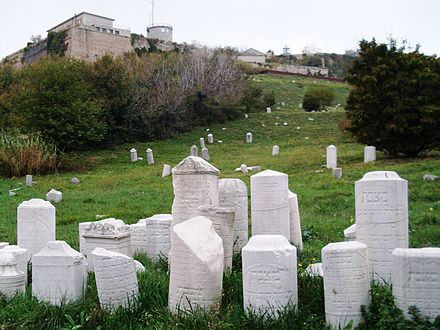Part 1
Nocera Inferiore
Part 2
Castellammare di Stabia
Part 3 - Brooklyn
Frank & Elizabeth
Lanzara Ancestral Chart
Giuseppe
Francesco
Cemeteries
Causes of Death
Photos
Documents
Email Me
ANCONA, ITALY

From Wikipedia:
Ancona (Greek: Ankon) is a city and a seaport in the Marche Region in central Italy, with a population of around 102,000 as of 2015. The city is located 170 miles northeast of Rome, on the Adriatic Sea. Ancona is one of the main ports on the Adriatic Sea, especially for passenger traffic, and is the main economic and demographic center of the region.
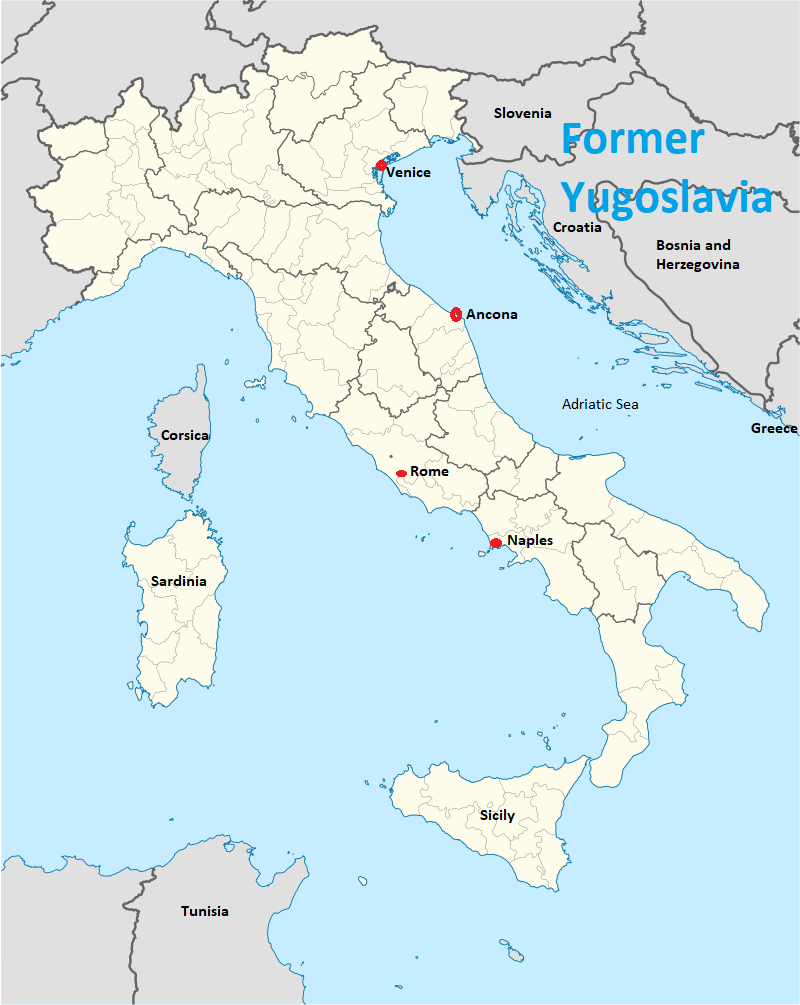
Greek colony
Ancona was founded by Greek settlers from Syracuse (Siracusa, on the eastern coast of Sicily) in about 387 BC, who gave it its name: Ancona stems from the Greek word Ankṓn, meaning "elbow"; the harbor to the east of the town was originally protected only by the promontory on the north, shaped like an elbow. Greek merchants established a Tyrian purple dye factory here. In Roman times it kept its own coinage with the punning device of the bent arm holding a palm branch and the head of Aphrodite on the reverse, and continued the use of the Greek language.
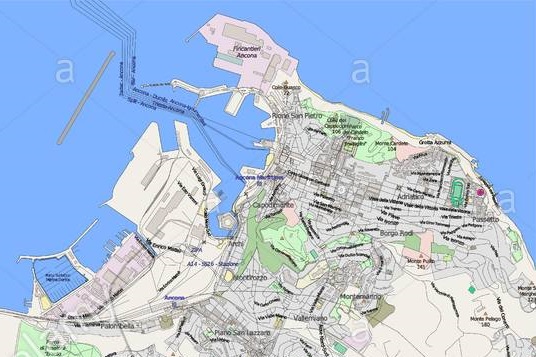
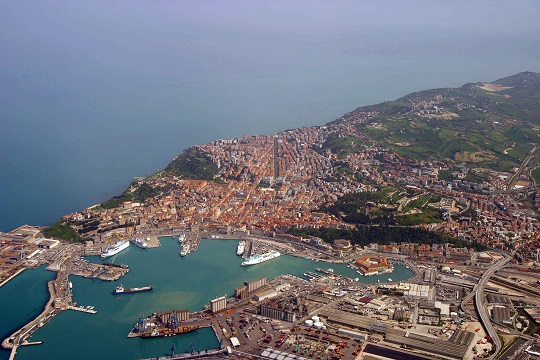
Roman Municipum
When it became a Roman town is uncertain. Julius Caesar took possession of it immediately after crossing the Rubicon River, located about 90 miles north of Ancona, in 49 BC. Its harbor was of considerable importance in imperial times, and was enlarged by Emperor Trajan, who constructed the north quay with his Syrian architect Apollodorus of Damascus. At the beginning of it stands the marble triumphal arch with a single archway, and without bas-reliefs, erected in his honor in 115 by the Senate and Roman people.
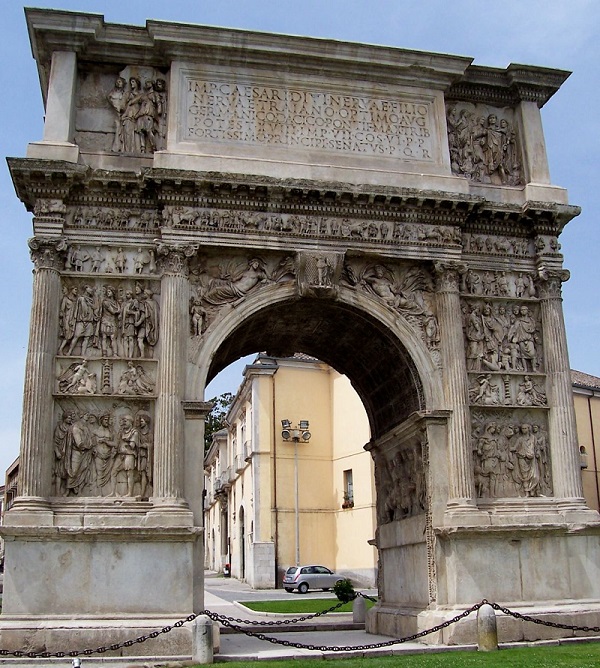
Byzantine city
Ancona was successively attacked by the Goths, Lombards and Saracens between the 3rd and 5th centuries, but recovered its strength and importance. It was one of the cities of the lordship of the Byzantine Empire, in the 7th and 8th centuries. In 840, Saracen raiders sacked and burned the city. After Charlemagne's conquest of northern Italy, it became the capital of the Marca di Ancona, whence the name of the modern region.
Maritime Republic of Ancona
After 1000 AD, Ancona became increasingly independent, eventually turning into an important maritime republic. In 1137, 1167 and 1174 it was strong enough to push back the forces of the Holy Roman Empire. Anconitan ships took part in the Crusades, and their navigators included Cyriac of Ancona. In the struggle between the Popes and the Holy Roman Emperors that troubled Italy from the 12th century onwards, Ancona sided with the Papacy.
Trade routes and warehouses of the maritime republic of Ancona
Different from other cities of northern Italy, Ancona never became a seignory (feudal lordship). The sole exception was the rule of the Malatesta family, who took the city in 1348, taking advantage of the black death and of a fire that had destroyed many of its important buildings. The Malatesta were ousted in 1383. In 1532 it definitively lost its freedom and became part of the Papal States, under Pope Clement VII. Symbol of the papal authority was the massive Citadel.
In the Papal States
Together with Rome, and Avignon in southern France, Ancona was the sole city in the Papal States in which the Jews were allowed to stay after 1569, living in the ghetto built after 1555. In 1733 Pope Clement XII extended the quay, and an inferior imitation of Trajan's arch was set up; he also erected a hospital for lepers at the south end of the harbor. The southern quay was built in 1880, and the harbor was protected by forts on the heights. From 1797 onwards, when the French took it, it frequently appears in history as an important fortress.
The Greek community of Ancona in the 16th century
Ancona, as well as Venice, became a very important destination for merchants from the Ottoman Empire during the 16th century. The Greeks formed the largest of the communities of foreign merchants. They were refugees from former Byzantine or Venetian territories that were occupied by the Ottomans in the late 15th and 16th centuries. The first Greek community was established in Ancona early in the 16th century. Natalucci, the 17th-century historian of the city, notes the existence of 200 Greek families in Ancona at the opening of the 16th century. Most of them came from northwestern Greece, i.e. the Ionian islands and Epirus.
In 1531 the Confraternity of the Greeks (Confraternita dei Greci) was established which included Orthodox Catholic and Roman Catholic Greeks. They secured the use of the Church of St. Anna dei Greci and were granted permission to hold services according to the Greek and the Latin rite. The church of St. Anna had existed since the 13th century, initially as "Santa Maria in Porta Cipriana," on ruins of the ancient Greek walls of Ancona.
In 1534 a decision by Pope Paul III favored the activity of merchants of all nationalities and religions from the Levant and allowed them to settle in Ancona with their families. A Venetian travelling through Ancona in 1535 recorded that the city was "full of merchants from every nation and mostly Greeks and Turks." In the second half of the 16th century, the presence of Greek and other merchants from the Ottoman Empire declined after a series of restrictive measures taken by the Italian authorities and the pope.
Disputes between the Orthodox Catholic and Roman Catholic Greeks of the community were frequent and persisted until 1797 when the city was occupied by France who closed all the religious confraternities and confiscated the archive of the Greek community. The French would return to the area to reoccupy it in 1805-1806. The church of St. Anna dei Greci was re-opened to services in 1822. In 1835, in the absence of a Greek community in Ancona, it passed to the Latin Church.
Contemporary history
Ancona entered the Kingdom of Italy when Christophe L on Louis Juchault de Lamorici re surrendered here on 29 September 1860, eleven days after his defeat at Castelfidardo. On 23 May 1915, Italy entered World War I and joined the Entente Powers. In 1915, following Italy's entry, the battleship division of the Austro-Hungarian Navy carried out extensive bombardments causing great damage to all installations and killing several dozen people. Ancona was one of the most important Italian ports on the Adriatic Sea during the Great War.
During World War II, the city was taken by the Polish 2nd Corps against Nazi German forces, as Free Polish forces were serving as part of the British Army. Poles were tasked with capture of the city on 16 June 1944 and accomplished the task a month later on 18 July 1944 in what is known as the battle of Ancona. The attack was part of an Allied operation to gain access to a seaport closer to the Gothic Line in order to shorten their lines of communication for the advance into northern Italy.
Jewish history
Jews began to live in Ancona in 967 A.D. In 1270, a Jewish resident of Ancona, Jacob of Ancona, travelled to China, four years before Marco Polo and documented his impressions in a book called "The City of Lights". From 1300 and on, the Jewish community of Ancona grew steadily, most due to the city importance and it being a center of trade with the Levant. In that year, Jewish poet Immanuel the Roman tried to lower high taxation taken from the Jewish community of the city. Over the next 200 years, Jews from Germany, Spain, Sicily and Portugal immigrated to Ancona, due to persecutions in their homeland and thanks to the pro-Jewish attitude taken towards Ancona Jews due to their importance in the trade and banking business, making Ancona a trade center. In 1550, the Jewish population of Ancona numbered about 2700 individuals.
In 1555, pope Paul IV forced the Crypto-Jewish community of the city to convert to Christianity, as part of his Papal Bull of 1555. While some did, others refused to do so and thus were hanged and then burnt in the town square. In response, Jewish merchants boycotted Ancona for a short while. The boycott was led by Dona Gracia Mendes Nasi.
Though emancipated by Napoleon I for several years, in 1843 Pope Gregory XVI revived an old decree, forbidding Jews from living outside the ghetto, wearing identification signs on their clothes and other religious and financial restrictions, though public opinion did not approve of these restrictions and they were cancelled a short while after.
The Jews of Ancona received full emancipation in 1848 with the election of Pope Pius IX. In 1938, 1177 lived in Ancona. 53 Jews were sent away to Germany, 15 of them survived and returned to the town after World War II. The majority of the Jewish community stayed in town or immigrated due to high ransoms paid to the fascist regime. In 2004, about 200 Jews lived in Ancona.
Two synagogues and two cemeteries still exist in the city. The ancient Monte-Cardeto cemetery is one of the biggest Jewish cemeteries in Europe and tombstones are dated to 1552 and on. It can still be visited and it resides within the Parco del Cardeto.
